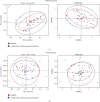Effect of Combined Live Probiotics Alleviating the Gastrointestinal Symptoms of Functional Bowel Disorders
- PMID: 33014039
- PMCID: PMC7519468
- DOI: 10.1155/2020/4181748
Effect of Combined Live Probiotics Alleviating the Gastrointestinal Symptoms of Functional Bowel Disorders
Abstract
Objective: Changes of the gut microbiota are related to the pathogenesis of functional bowel disorders (FBDs), and probiotic supplementation may be an effective treatment option. Therefore, we aimed to investigate the effect of combined live probiotics on the gastrointestinal symptoms of FBDs via altering the gut microbiota.
Methods: Patients with the gastrointestinal symptoms of FBDs attending the Outpatient Department, from July to November 2019, were recruited. After the bowel preparation with polyethylene glycol electrolyte powder and colonoscopy, patients with normal result of colonoscopy were randomly divided into the probiotics group and control group. Patients in the probiotics group were prescribed with combined live Bacillus subtilis and Enterococcus faecium enteric-coated capsules for 4 weeks. Small intestinal bacteria overgrowth (SIBO) was measured by lactulose hydrogen breath test, and the microbial DNA was extracted from the fecal samples and the bacteria were classified by 16S rDNA gene amplicon sequencing.
Results: Twenty-five patients of each group were recruited, and there was no significant difference between the probiotics and control groups on baseline gastrointestinal symptom rating scale (GSRS), positive rate of SIBO, and relative abundances of the gut microbiota at the phylum level. After 4 weeks of treatment, the values of the probiotics and control groups were as follows: GSRS 1.4 ± 1.4 and 3.6 ± 1.6 and positive rate of SIBO 28.0% and 56.0%, respectively. The median relative abundances of the gut microbiota were 1.01% and 5.03% Actinobacteria and 43.80% and 35.17% Bacteroidetes at the phylum level; 0.76% and 3.29% Bifidobacterium, 0.13% and 0.89% Cillinsella, 0.03% and 0.01% Enterococcus, 0.18% and 0.36% Lachnospiraceae, 0.10% and 0.16% Ruminococcus torques group, 1.31% and 2.44% Blautia, and 0.83% and 2.02% Fusicatenibacter at the genus level (P < 0.05), respectively.
Conclusion: Combined live probiotic supplementation after the bowel preparation can alter the gut microbiota, decontaminate SIBO, and alleviate the gastrointestinal symptoms of FBDs. This trial is registered with ChiCTR1900026472.
Copyright © 2020 Jin Shi et al.
Conflict of interest statement
The authors declare no competing interest.
Figures





Similar articles
-
Clinical study on sequential treatment of severe diarrhea irritable bowel syndrome with precision probiotic strains transplantation capsules, fecal microbiota transplantation capsules and live combined bacillus subtilis and enterococcus faecium capsules.Front Cell Infect Microbiol. 2022 Sep 28;12:1025889. doi: 10.3389/fcimb.2022.1025889. eCollection 2022. Front Cell Infect Microbiol. 2022. PMID: 36250045 Free PMC article.
-
Beneficial effect of probiotics supplements in reflux esophagitis treated with esomeprazole: A randomized controlled trial.World J Gastroenterol. 2019 May 7;25(17):2110-2121. doi: 10.3748/wjg.v25.i17.2110. World J Gastroenterol. 2019. Retraction in: World J Gastroenterol. 2023 Jan 7;29(1):221-222. doi: 10.3748/wjg.v29.i1.221. PMID: 31114137 Free PMC article. Retracted. Clinical Trial.
-
Suppression of Berberine and Probiotics (in vitro and in vivo) on the Growth of Colon Cancer With Modulation of Gut Microbiota and Butyrate Production.Front Microbiol. 2022 Apr 28;13:869931. doi: 10.3389/fmicb.2022.869931. eCollection 2022. Front Microbiol. 2022. PMID: 35572672 Free PMC article.
-
Probiotics in functional bowel disorders.Best Pract Res Clin Gastroenterol. 2016 Feb;30(1):89-97. doi: 10.1016/j.bpg.2016.01.003. Epub 2016 Jan 14. Best Pract Res Clin Gastroenterol. 2016. PMID: 27048900 Review.
-
Small Intestinal Bacterial Overgrowth and Irritable Bowel Syndrome: A Bridge between Functional Organic Dichotomy.Gut Liver. 2017 Mar 15;11(2):196-208. doi: 10.5009/gnl16126. Gut Liver. 2017. PMID: 28274108 Free PMC article. Review.
Cited by
-
Association of small intestinal bacterial overgrowth with nonalcoholic fatty liver disease in children: A meta-analysis.PLoS One. 2021 Dec 2;16(12):e0260479. doi: 10.1371/journal.pone.0260479. eCollection 2021. PLoS One. 2021. PMID: 34855819 Free PMC article.
-
Washed microbiota transplantation improves symptoms and intestinal barrier function in patients with functional bowel disorders: a propensity-score matching analysis.BMC Gastroenterol. 2024 Jan 23;24(1):45. doi: 10.1186/s12876-024-03131-z. BMC Gastroenterol. 2024. PMID: 38262980 Free PMC article.
-
Bacillus Subtilis (BG01-4TM) Improves Self-Reported Symptoms for Constipation, Indigestion, and Dyspepsia: A Phase 1/2A Randomized Controlled Trial.Nutrients. 2023 Oct 24;15(21):4490. doi: 10.3390/nu15214490. Nutrients. 2023. PMID: 37960143 Free PMC article. Clinical Trial.
-
CO2 Is Beneficial to Gut Microbiota Homeostasis during Colonoscopy: Randomized Controlled Trial.J Clin Med. 2022 Sep 7;11(18):5281. doi: 10.3390/jcm11185281. J Clin Med. 2022. PMID: 36142931 Free PMC article.
References
LinkOut - more resources
Full Text Sources

